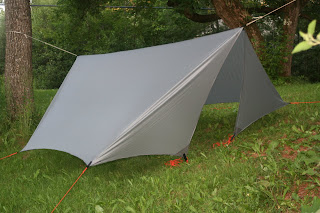On the day before our trip, a couple friends and I went to scout out our intended camp location on Tunk Lake. It's good we did. This was supposed to be a quick hike in, check it out, and hike back.
Turns out there is absolutely no route to the camp sites by foot, you've got to go by boat. We did get to the sites, by foot - with a compass and map and lots of rock hopping along the shore. Four and half hours of it. We learned what we needed to learn. Tunk Lake is a no-go.
So we went to Donnell Pond, on the southern end at Schoodic Beach. The place is fantastic and if you're ever in Maine for a campout, check it out. Sand is a rarity here in Maine and Schoodic Beach has a great, long, sandy beach with great swimming.
 Look... sand... in Maine!
Look... sand... in Maine!
 A view down a portion of Schoodic Beach.
A view down a portion of Schoodic Beach.
It's just a half mile hike down a wide trail to the campsites at the southern end (there are lots more sites that you can get to by boat). This end has four marked sites with picnic tables. We took one with more trees as we had more hammocks than tents.
 View of a couple hammocks set up. A Hennessy on the left and my homemade rig on the right.
View of a couple hammocks set up. A Hennessy on the left and my homemade rig on the right.
On Saturday we hiked up Schoodic Mountain. It's a short mountain, only 1000ft to the summit. The remnants of the tropical storm Bill were threatening, but didn't show up until the night. It's a nice, leisurely hike (though some who came would argue that point) with what could possibly have been a nice view at the top. We had a grand view of the fog.
 A look down from part way up the mountain. Schoodic Beach is on the right.
A look down from part way up the mountain. Schoodic Beach is on the right.
 Here was our beautiful view at the top of Schoodic Mountain.
Here was our beautiful view at the top of Schoodic Mountain.
The cooksets we made worked out wonderfully. The boys did a great job with being safe and not burning down the forest. Eight people, only one with prior SuperCat experience, firing off these stoves all weekend and nothing terribly dangerous happened... I'd call that successful. We had mac'n'cheese, spaghetti, ramen noodles, oatmeal, and lots of hot drinks.
 Here's Joe eating his mac'n'cheese. He'd forgotten silverware so is using his hunting knife. Kids, don't try this at home.
Here's Joe eating his mac'n'cheese. He'd forgotten silverware so is using his hunting knife. Kids, don't try this at home.
 Some mac'n'cheese with hotdogs tossed in.
Some mac'n'cheese with hotdogs tossed in.
 Just pickin' my teeth after a meal with my itty-bitty camp knife.
Just pickin' my teeth after a meal with my itty-bitty camp knife.
On Saturday night the remnants of tropical storm Bill swept through. I learned a valuable lesson. Seam sealing the ridgeline on your tarp actually is fairly important. It was some powerful wind and rain, and the ridgeline right over my head dripped something fierce. I had to get out at 2:00am and adjust the tarp to where the ridgeline wouldn't drip on my hammock. I need to see to that seam sealing asap.
We also had to pack up in the rain. Not my favorite, but it went really well. I've got tarps out to dry right now in my side yard, and need to set up the junk tent that a couple boys used to let it dry out as well. But all in all, a smooth process.
 My adjusted tarp so the ridgeline wouldn't drip on me all night. The hammock and I were fairly wet by the time I got this done.
My adjusted tarp so the ridgeline wouldn't drip on me all night. The hammock and I were fairly wet by the time I got this done.
The only real downfall of the trip was our neighbors. They'd been living there for at least a month and a half (14 days is the legal limit here). Social skills were at a minimum with these folks, and one girl had a mouth on here that would make a sailor blush... and no volume control or others awareness. They seemed to relegate thair loud and obnoxious talk to early in the morning and very late at night (midnight to 3am). That, and the pungent smell of marijuana wafting through each evening from their campsite made for some frustration. I think if they spent a little less on the weed and a little more on rent they'd be doing everyone a favor.
I hope folks like that are gone when you visit.
All in all though, a great weekend with the boys.





















































